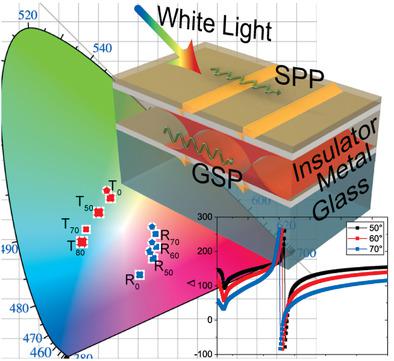当前位置:
X-MOL 学术
›
Adv. Opt. Mater.
›
论文详情
Our official English website, www.x-mol.net, welcomes your feedback! (Note: you will need to create a separate account there.)
Color Gamut Behavior in Epsilon Near‐Zero Nanocavities during Propagation of Gap Surface Plasmons
Advanced Optical Materials ( IF 9 ) Pub Date : 2020-06-10 , DOI: 10.1002/adom.202000487 Giuseppe Emanuele Lio 1, 2 , Antonio Ferraro 1, 2 , Michele Giocondo 1 , Roberto Caputo 1, 2, 3 , Antonio De Luca 1, 2
Advanced Optical Materials ( IF 9 ) Pub Date : 2020-06-10 , DOI: 10.1002/adom.202000487 Giuseppe Emanuele Lio 1, 2 , Antonio Ferraro 1, 2 , Michele Giocondo 1 , Roberto Caputo 1, 2, 3 , Antonio De Luca 1, 2
Affiliation

|
This work reports on numerical and experimental results obtained in plasmonic metal–insulator nanocavities. The systems are composed of silver as metal, and different materials as insulator, namely polyvinylpyrrolidone (PVP), indium tin oxide (ITO), and zinc oxide (ZnO). The proposed nanocavities exhibit extraordinary optical effects as tunable color hue, highlighted in gamut maps, depending on incident/viewing angles, extraordinary transmission and zero reflection at resonant wavelengths, for different incident polarizations. These phenomena are related to the formation of surface plasmon polaritons (SPPs) and gap surface plasmons (GSPs) whose presence is evidenced by a remarkable sigmoidal behavior of the pseudo dielectric function, with epsilon‐near‐zero singularities in its real and imaginary parts. This function is directly calculated from the measured ellipsometric parameters Ψ and Δ and allows probing, in a fast and effective way, the existence of the plasmonic modes. Moreover, in presence of these singularities, the ellispometric analysis of the systems also shows a pronounced dephasing between p‐ and s‐reflected beams that can lead to a Goos–Hänchen shift effect to be exploited for sensing applications. Thanks to their unusual optical properties, the proposed nanocavities open a wide scenario of applications in fields like tunable color filters, optics, photonics, physical security, and sensing.
中文翻译:

Epsilon近零纳米腔在间隙表面等离激元传播过程中的色域行为
这项工作报告了在等离子体金属-绝缘体纳米腔中获得的数值和实验结果。该系统由作为金属的银和作为绝缘体的不同材料构成,即聚乙烯吡咯烷酮(PVP),氧化铟锡(ITO)和氧化锌(ZnO)。所提出的纳米腔体表现出非同寻常的光学效果,如可调谐的色相,在色域图中突出显示,取决于入射/视角,非凡的透射率和共振波长下的零反射(针对不同的入射偏振)。这些现象与表面等离激元极化子(SPPs)和间隙表面等离激元(GSPs)的形成有关,其存在由伪介电函数的显着S型行为证明,其实部和虚部具有ε接近零的奇点。该函数直接从测得的椭偏参数Ψ和Δ计算得出,并允许以快速有效的方式探测等离子体激元模式的存在。此外,在存在这些奇异性的情况下,系统的椭偏分析还显示p和s反射光束之间存在明显的相移,这可能导致Goos–Hänchen位移效应被用于传感应用。由于其异常的光学特性,拟议的纳米腔体在可调谐滤色镜,光学器件,光子学,物理安全性和传感等领域打开了广泛的应用前景。系统的椭偏分析也显示p和s反射光束之间存在明显的相移,这可能导致Goos–Hänchen位移效应被用于传感应用。由于它们具有异常的光学特性,因此所提出的纳米腔体在可调谐滤色镜,光学器件,光子学,物理安全性和传感等领域打开了广泛的应用前景。系统的椭偏分析也显示p和s反射光束之间存在明显的相移,这可能导致Goos–Hänchen位移效应被用于传感应用。由于其异常的光学特性,拟议的纳米腔体在可调谐滤色镜,光学器件,光子学,物理安全性和传感等领域打开了广泛的应用前景。
更新日期:2020-06-10
中文翻译:

Epsilon近零纳米腔在间隙表面等离激元传播过程中的色域行为
这项工作报告了在等离子体金属-绝缘体纳米腔中获得的数值和实验结果。该系统由作为金属的银和作为绝缘体的不同材料构成,即聚乙烯吡咯烷酮(PVP),氧化铟锡(ITO)和氧化锌(ZnO)。所提出的纳米腔体表现出非同寻常的光学效果,如可调谐的色相,在色域图中突出显示,取决于入射/视角,非凡的透射率和共振波长下的零反射(针对不同的入射偏振)。这些现象与表面等离激元极化子(SPPs)和间隙表面等离激元(GSPs)的形成有关,其存在由伪介电函数的显着S型行为证明,其实部和虚部具有ε接近零的奇点。该函数直接从测得的椭偏参数Ψ和Δ计算得出,并允许以快速有效的方式探测等离子体激元模式的存在。此外,在存在这些奇异性的情况下,系统的椭偏分析还显示p和s反射光束之间存在明显的相移,这可能导致Goos–Hänchen位移效应被用于传感应用。由于其异常的光学特性,拟议的纳米腔体在可调谐滤色镜,光学器件,光子学,物理安全性和传感等领域打开了广泛的应用前景。系统的椭偏分析也显示p和s反射光束之间存在明显的相移,这可能导致Goos–Hänchen位移效应被用于传感应用。由于它们具有异常的光学特性,因此所提出的纳米腔体在可调谐滤色镜,光学器件,光子学,物理安全性和传感等领域打开了广泛的应用前景。系统的椭偏分析也显示p和s反射光束之间存在明显的相移,这可能导致Goos–Hänchen位移效应被用于传感应用。由于其异常的光学特性,拟议的纳米腔体在可调谐滤色镜,光学器件,光子学,物理安全性和传感等领域打开了广泛的应用前景。


























 京公网安备 11010802027423号
京公网安备 11010802027423号